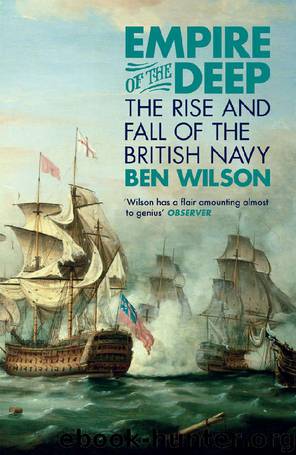Empire of the Deep: The Rise and Fall of the British Navy by Ben Wilson

Author:Ben Wilson [Wilson, Ben]
Language: eng
Format: epub
Publisher: Orion
Published: 2013-07-24T22:00:00+00:00
* Before the Battle of Toulon there had been twenty-six years of peace, before Minorca nine, and before Ushant nineteen.
CHAPTER 32
TACTICS
1779–1782
My eye on them had more dread than the enemy’s fire, and they knew it would be more fatal.1
Admiral Rodney, speaking about his captains
Rodney was eight years older than Howe. Both had roughly comparable careers. Rodney was captain of HMS Eagle at the Second Battle of Finisterre and, like Howe, distinguished himself as a bold young fighting officer in the Seven Years War. He led superb amphibious operations against Le Havre, Martinique, St Lucia, Grenada and St Vincent. Like Howe he had a brilliant record and a questing tactical mind, but he besmirched it with a tyrannical style of leadership, notorious dishonesty when it came to money, and ruinously expensive addictions to gambling and politics.
Rodney managed to dodge his creditors by taking the post of commander of the Jamaica Station. But he had to come home eventually. In 1774 he was driven into exile in France to avoid debtors’ gaol. Four years later, when Britain and France declared war, Rodney had to return home, but in order to do so he had to claim his back pay as rear admiral to satisfy his ravenous creditors. The Admiralty, however, would not pay him until an ugly dispute over embezzled funds was resolved. In the end his passage home was smoothed by a generous gift from a French duke.
Rodney’s fleet was state-of-the-art. Warships had always suffered from prolonged service in distant waters where there were no facilities for dry-docking. Hulls were weakened by shipworm and speed was reduced over the course of a cruise by the build-up of weeds and barnacles. The solution was to sheathe hulls in copper.
Rodney’s squadron consisted entirely of copper-bottomed ships. Not only were the ships more durable, but the copper sheaths considerably increased their speed. Now the biggest, most lumbering three-decker in the Royal Navy could outpace the fastest ship in its enemies’ fleets. The possibilities for battle strategy and manoeuvres were therefore endless.
The first part of Rodney’s command was brilliantly executed. Gibraltar was under prolonged siege from the Spanish army and needed frequent resupply. Rodney escorted the convoy that relieved Gibraltar. Shortly after he captured sixteen ships from a Spanish convoy. Then, off St Vincent on the afternoon of 16 January, a Spanish squadron of eleven ships of the line and two frigates was sighted. Rodney ordered an immediate chase. It was a risky action, in darkness on a lee shore. By midnight six Spanish ships had been captured and one had blown up. Rodney acted with resolution and aggression, qualities that had earned his appointment in the first place. ‘To bring an enemy to action, copper bottom ships are absolutely necessary,’2 he concluded. The new technology proved its worth in the Moonlight Battle, as it was called.
Rodney arrived at St Lucia in late March and joined forces with Rear Admirals Sir Hyde Parker and Joshua Rowley, bringing British strength in the region to twenty-one battleships.
Download
This site does not store any files on its server. We only index and link to content provided by other sites. Please contact the content providers to delete copyright contents if any and email us, we'll remove relevant links or contents immediately.
| Africa | Americas |
| Arctic & Antarctica | Asia |
| Australia & Oceania | Europe |
| Middle East | Russia |
| United States | World |
| Ancient Civilizations | Military |
| Historical Study & Educational Resources |
Room 212 by Kate Stewart(4735)
The Crown by Robert Lacey(4572)
Endurance: Shackleton's Incredible Voyage by Alfred Lansing(4503)
The Iron Duke by The Iron Duke(4120)
The Rape of Nanking by Iris Chang(4022)
Killing England by Bill O'Reilly(3897)
Joan of Arc by Mary Gordon(3782)
Say Nothing by Patrick Radden Keefe(3725)
I'll Give You the Sun by Jandy Nelson(3272)
Shadow of Night by Deborah Harkness(3173)
Hitler's Monsters by Eric Kurlander(3164)
Mary, Queen of Scots, and the Murder of Lord Darnley by Alison Weir(3063)
Blood and Sand by Alex Von Tunzelmann(3055)
Darkest Hour by Anthony McCarten(3018)
Margaret Thatcher: The Autobiography by Thatcher Margaret(2971)
Eleanor & Park by Rainbow Rowell(2943)
Red Famine: Stalin's War on Ukraine by Anne Applebaum(2816)
Book of Life by Deborah Harkness(2717)
The One Memory of Flora Banks by Emily Barr(2684)
